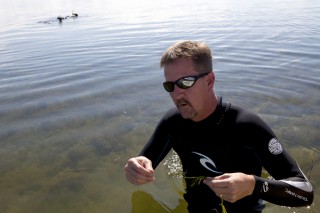UF/IFAS Research Findings Shed Light on Seagrass Needs

Tom Frazer, a professor of aquatic ecology and director of the School of Natural Resources and Environment at UF/IFAS, looks for seagrass in Florida's Gulf Coast. A new study Frazer helped supervise shows how much light seagrass need to survive.
Loss of seagrass means fish, crabs and other animals lose their homes and manatees and sea turtles lose a source of food. Nutrients, such as phosphorous, may prevent seagrass from getting the sunlight it needs to thrive. Nutrients may come from many sources, among them fertilizers used in agriculture, golf courses and suburban lawns, pet waste and septic tank waste.
Scientists often use seagrass to judge coastal ecosystems’ vitality, said Chuck Jacoby, a courtesy associate professor in the Department of Soil and Water Science and co-author of a new UF study that examines light and seagrass health.
“By protecting seagrass, we protect organisms that use seagrass and other photosynthetic organisms that need less light,” said Jacoby, a faculty member in UF’s Institute of Food and Agricultural Sciences.
When nutrient levels are too high, microorganisms in the water, called phytoplankton, use these nutrients and light to grow and reproduce until they become so abundant that they block sunlight seagrass needs to survive, said Zanethia Choice, a former UF graduate student who led the investigation.
“Seagrass can cope with short-term light reductions, but if those conditions last too long or occur too frequently, seagrass will deteriorate and ultimately die,” Choice said. “Good water clarity is vital for healthy coastal systems.”
Choice studied seagrass beds in a 700,000-acre swath off the coast of Florida’s Big Bend.
Choice, now a natural resource specialist with the U.S. Forest Service in Mississippi, conducted the study as part of her master’s thesis, under the supervision of Jacoby and Tom Frazer, a professor of aquatic ecology and director of the UF School of Natural Resources and Environment.
Choice combined 13 years of light and water quality data and two years of seagrass samples from habitats near the mouths of eight rivers that empty into the Gulf of Mexico.
Seagrass off the Steinhatchee, Suwannee, Waccasassa, Withlacoochee, Crystal, Homosassa, Chassahowitzka and Weeki Wachee rivers constitutes part of the second largest seagrass bed in Florida. The largest bed is in Florida Bay, between the Everglades and the Florida Keys, Jacoby said.
Choice wanted to see how much light was needed to keep the seagrass in this region healthy. She found different seagrass species needed varying amounts of light, ranging from 8 to 27 percent of the sunlight at the water’s surface.
The UF/IFAS study will give water resource managers, such as the state Department of Environmental Protection, water-clarity targets they can use to set proper nutrient levels for water bodies, Jacoby said.
Reducing nutrient levels can promote the health of seagrass and coastal waters. For example, concerted efforts to reduce nutrients flowing into Tampa Bay over the past 20-plus years resulted in a 50 percent reduction in nitrogen, a 50 percent increase in water clarity and a return of lost seagrass, according to a study conducted by the Tampa Bay Estuary Program.
Unlike Tampa Bay, there is no evidence that elevated nutrient levels in Choice’s study area have led to loss of seagrass. UF researchers are trying to make sure nutrients do not pollute the seagrass beds off the coast of the Big Bend, and they hope their results will guide managers as they strive to prevent any damage.
The study of seagrass light requirements is published in this month’s issue of the journal Marine Pollution Bulletin.
Sources: Zanethia Choice, 662-234-2744 ext. 268, zdchoice@fs.fed.us
Chuck Jacoby, 352-273-3631, cajacoby@ufl.edu
Media Contact
More Information:
http://www.ufl.eduAll latest news from the category: Ecology, The Environment and Conservation
This complex theme deals primarily with interactions between organisms and the environmental factors that impact them, but to a greater extent between individual inanimate environmental factors.
innovations-report offers informative reports and articles on topics such as climate protection, landscape conservation, ecological systems, wildlife and nature parks and ecosystem efficiency and balance.
Newest articles

Long-sought structure of powerful anticancer natural product
…solved by integrated approach. A collaborative effort by the research groups of Professor Haruhiko Fuwa from Chuo University and Professor Masashi Tsuda from Kochi University has culminated in the structure…

Making a difference: Efficient water harvesting from air possible
Copolymer solution uses water-loving differential to induce desorption at lower temperatures. Harvesting water from the air and decreasing humidity are crucial to realizing a more comfortable life for humanity. Water-adsorption…

In major materials breakthrough
UVA team solves a nearly 200-year-old challenge in polymers. UVA researchers defy materials science rules with molecules that release stored length to decouple stiffness and stretchability. Researchers at the University…



